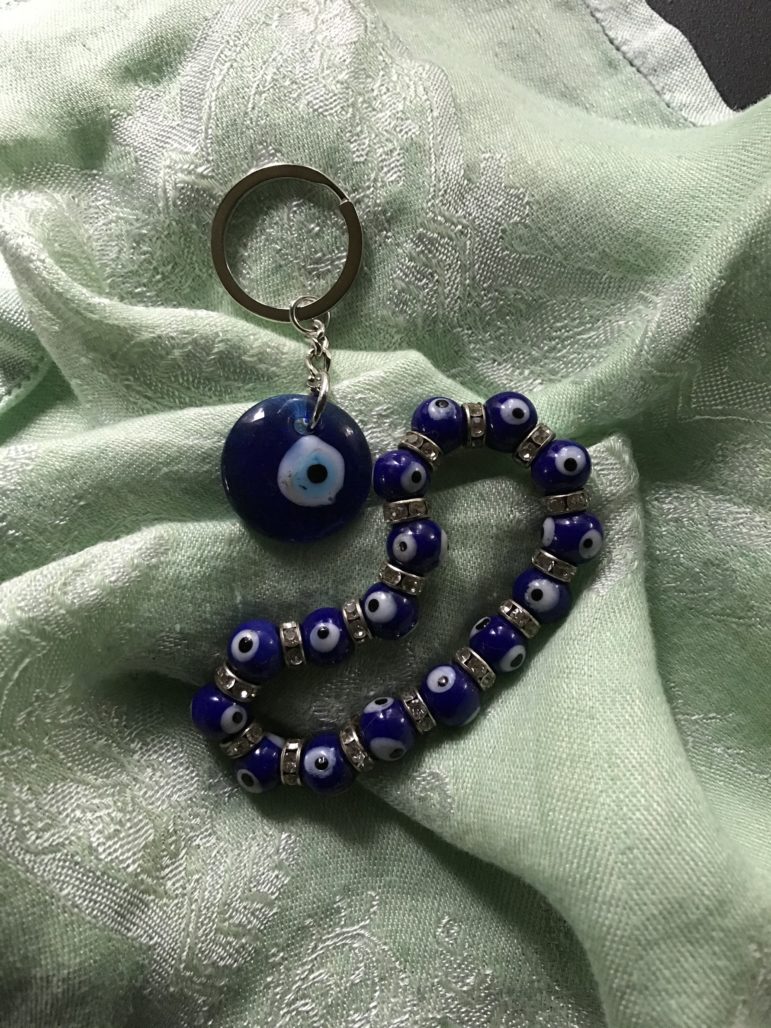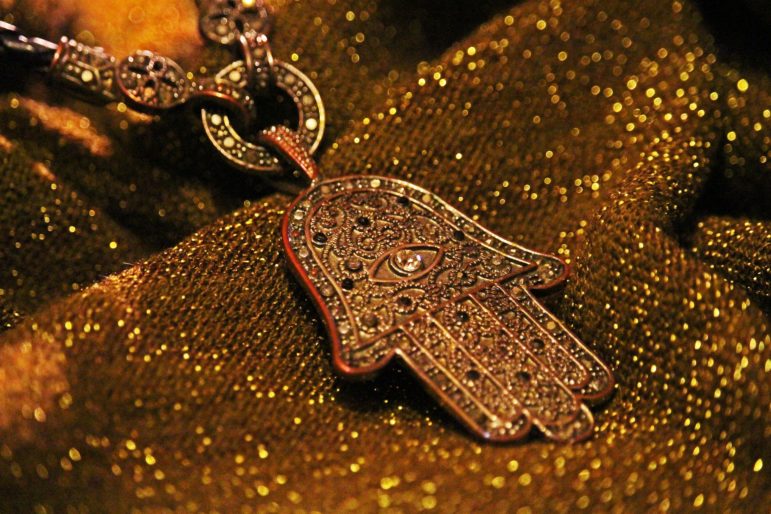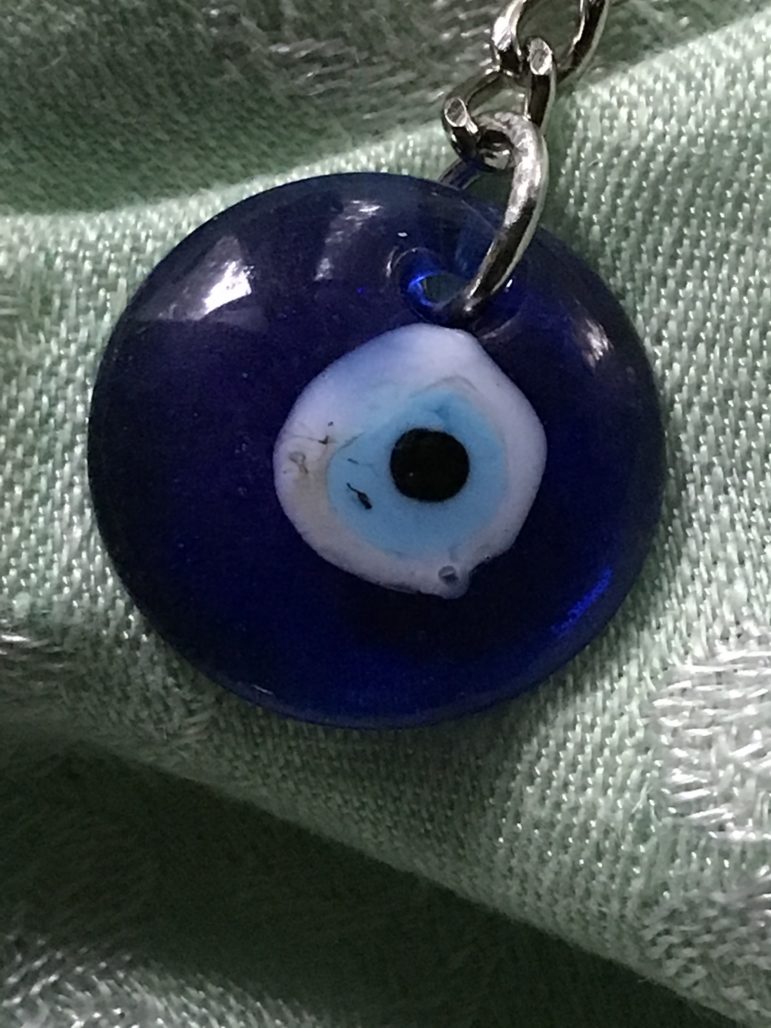
TWH – A single glance is all it takes. It could come from a friend, a family member, or a complete stranger. It could happen on a busy city street or along a quiet country road. The evil eye – a curse that stems from someone’s envy or ill will – is ubiquitous and, according to countless magical practitioners, incredibly powerful.
Few superstitions elicit as much fear, and understandably so. The “eye” doesn’t require one to light a candle or recite an incantation. A well-placed stare, the simplest of human actions, can deliver bad luck or the onset of a physical ailment.
Nearly every culture has its own version of the storied malediction. In Italian, it’s called malocchio. In Greece, it’s mati. Some believe it is intentional, while others favor the theory that “the eye” can be unleashed unconsciously if one person feels even a twinge of jealousy towards another.

Nazar amulets in the form of a bracelet and keychain – Image credit: S. Bustamonte
So what, exactly, is the evil eye?
“The origins of the evil eye belief complex are shrouded in history. However, we know that it goes back at least as far as ancient Egyptian civilization, approximately 5,000 years BCE. We know that the ancient Egyptians had a symbol called the udjat, consisting of an eye, which they painted on boats, coffins, tombs, and objects to protect them against the evil eye,” said Dr. Sabina Magliocco, a professor of anthropology at the University of British Columbia and the author of Witching Culture: Folklore and Neo-Paganism in America.
“As in modern anti-evil charms, the eye acted as an apotropaic device, bouncing away any evil intentions. We know from literature and archaeological remains that the ancient Greeks and Romans also believed in this system in which the gaze of an envious person was thought to cause harm. The evil eye belief complex has continued to exist throughout the Mediterranean and in places colonized by Mediterranean peoples, such as Latin America, for 7,000 years,” she related.
Christopher Penczak, co-founder of the Temple of Witchcraft tradition and the author of numerous landmark books, learned about the evil eye in childhood from his mother’s family.
“My mother’s godmother was a ‘curse breaker’ in the Italian section of the city of Lawrence, Massachusetts who would break the malocchio with a spaghetti pot of boiling water on the stove, extra virgin olive oil, and a needle, while saying prayers to Jesus and Mary,” he said. “The first time I was in the living room of her home when she was doing it, and they wouldn’t let me watch, but my mother did describe it to me. I was fascinated.”
Despite these early encounters, he came to understand “the eye” more fully as an adult. “Later, as an occultist, I understood the evil eye to be often unintentional, but very real harm caused by someone’s strong and harmful feelings towards you or your family, disrupting your sense of connection to being on your path, which causes misfortune or illness,” he said.
A common thread linking the evil eye to those practicing the magic that cures it is family lineage. Rituals are often passed down from one generation to the next, and many modern-day practitioners can trace their working knowledge of the eye to their parents or grandparents.
Leanne Marrama, co-author of the forthcoming Lighting the Wick: An Intuitive Guide to the Ancient Art and Magic of Candles and co-owner of Pentagram, a Witchcraft shop in Salem, Massachusetts, explained that many people are misinformed about what the evil eye truly is.
“The evil eye is often portrayed as a curse cast by a vindictive jealous practitioner of malevolent magic,” she said. “But the eye is more commonly caused by feelings of jealousy and envy by people we associate with daily. My own grandmother believed that insincere compliments to her children and grandchildren were forms of the evil eye. None of us were safe from her randomly spitting on the ground or us, for that matter, with the hopes of protecting us from the dreaded evil eye.”
Over the years Marrama has diagnosed the evil eye for various family members and friends. One test for detecting its presence utilizes olive oil and a bowl of water.
“If the oil forms one large drop in the middle of the plate,” Marrama said, “then it is a sure sign of the evil eye.”
Like countless other Witches and practitioners of folk magic, Marrama acknowledged that there are many ways to both detect and remove the evil eye; in fact, rituals vary from culture to culture, if not family to family.
“My mother’s side of the family and my father’s side of the family had two different ways of identifying and busting the evil eye,” she explained. “My mother used scissors and my aunt used a silver steak knife. Other families use pins or razors stabbed directly into the oily eye, followed by three pinches of salt.”
Marrama further illustrated the ritual through the lens of her own Italian heritage. She explained that the strega – an Italian Witch – will “say secret words or simply the Hail Mary three times” to break or banish the negativity. “Often an egg is dropped into the bowl filled with water and oil,” she added. “The egg absorbs the evil and is then tossed into the toilet.”
In recent years, books and online tutorials have explored the evil eye from the perspective of the modern practitioner, but history remains the best teacher. Among the world’s major monotheistic religions, Judaism and Jewish culture are also replete with references to the evil eye.
Whether using the Yiddish phrase kinnahora or the Hebrew phrase bli ayn hara, many Jewish people seek to ward off the evil eye, the ayn hara, from impacting good news or good fortune.
“The evil eye is not mentioned in the Hebrew Bible, nor is it mentioned in Jewish literature of the Second Temple period,” said Dr. Gideon Bohak, a professor in the department of Jewish Philosophy at Tel Aviv University and author of Ancient Jewish Magic: A History. “But it does appear in Rabbinic literature of the first few centuries AD, and is attested in Jewish texts and practices to this very day.”
Among the practices that Jewish people have developed over the centuries are spitting three times after mentioning plans or positive developments, as seen in films like Fiddler on the Roof, or wearing a variety of different kinds of amulets for protection.
These can include a hamsa, a hand-shaped shield that is sometimes cast with a jeweled eye in its center. It is called the hand of Fatima or Miriam, depending on the wearer, and is said to originate from the Muslim world and was also adopted by Jews who hail from that part of the world.

Hand of Fatima charm – Image credit: Kerstin Riemer from Pixabay
There is also the ben porat yosef prayer, cast on a variety of metals, which offers protections to the descendants of the Biblical character Joseph, who are said to be immune from the powers of “the eye.”
The Talmud, the compendium of Jewish law and legends, even offers a ritual to confront its powers: “One who enters a city and fears the evil eye should hold the thumb of his right hand in his left hand and the thumb of his left hand in his right hand and recite the following: I, so-and-so son of so-and-so, come from the descendants of Joseph, over whom the evil eye has no dominion. (Berakhot 55b)”
Both Bohak and Magliocco address the compelling fact that belief in the evil eye has an enduring quality. Neither the passage of time nor the impact of an increasingly secular society have weakened its efficacy.
Among today’s most popular forms of protection is the wearing of a nazar, a blue amulet that resembles an eye, which can be found across the Arab world, Turkey, and Greece. Terms like bad juju and negative energy are used colloquially, and each is rooted in what the evil eye ultimately represents. What is its staying power?
“The belief system survives because it serves a psychological and social function,” said Magliocco. “Evil eye belief is usually about social relations, not supernatural ones. It reflects the fear of envy that characterizes small-scale societies the world over. In tightly-knit, egalitarian communities with a shared concept of limited good – that is, a belief that the amount of available good things is limited – one person’s good fortune necessarily comes at the expense of someone else. That applies not only to material wealth, but to fertility, happiness, success, and other intangibles. Therefore, people believe that if they have something good, others will envy them.”
Bohak concurs. “I think this is a combination of several things,” he said. “On the one hand, the evil eye is a form of jealousy, which makes people afraid that the jealousy of others in their own success might somehow hurt them. On the other, the very gaze of people (and animals, especially dangerous animals) is psychologically very disturbing. I think this is why the eye became such a focal point of human fears of how other humans might harm them – on purpose or even inadvertently.”
Beyond envy, the evil eye can also be attributed to other factors such as interpersonal struggles.
“We all have people with whom we might be in conflict – neighbors, ex-spouses, coworkers,” Magliocco said. “Evil eye belief allows us to project bad feelings onto the person we are in conflict with, as well as explaining misfortune: it’s their fault we have a headache or upset stomach, because they wished us ill through the evil eye! They caused us to have a run of bad luck because they’re angry with us; we can hold ourselves blameless.”

A nazar charm to protect against the evil eye – Image credit: S. Bustamonte
There are numerous rituals to remove the evil eye, but what is the source of their development over time? Oil, water, salt, scissors, furtive incantations – are these remnants of Pagan rites that were syncretized with other religious and ethnic beliefs?
“It is very difficult to find evidence of the roots of practices to cure or remove the evil eye, because these practices were passed down through oral tradition and imitation for centuries by ordinary people who were usually non-literate,” Magliocco explained. “It is very likely, though, that practices such as using water and oil to diagnose and cure the evil eye predate Christianity, and that the prayers to saints for a cure were added when Christianity became the dominant religion. Certainly, the use of eye-shaped amulets to prevent the evil eye dates back to ancient Egyptian civilization, and therefore has Pagan roots. It’s worth noting, however, that often, practices with Pagan roots combine with practices from monotheistic religions (Judaism, Christianity, Islam) in the prevention and cure of the evil eye.”
Magic differs greatly among practitioners, but most will agree that one ingredient is a mainstay when it comes to combating the evil eye: water. Magliocco sheds light on a curious – and often overlooked – piece of the puzzle.
“Some scholars have noted that many evil eye diagnoses and cures involve the use of water,” Magliocco said. “They have linked this to the generally dry Mediterranean climate where the belief system originated, and the idea that wetness signified life and health, while dryness was associated with shriveling up, disease, and death. Given the importance of water access throughout the Mediterranean and Middle East, this would indicate the very ancient roots of this belief system.”
The scope of magical practice has grown over the past several decades, and so too have the Witches, Pagans, and folk practitioners who are continually fostering its prominence on the spiritual landscape.
The “old ways” – the rituals and prayers of the ancestors – have never been more significant; some are reclaiming those ways and others are reshaping them to better serve the changing needs of their own communities.
And so it is with the evil eye. Witches like Penczak and Marrama were taught the traditional methods for removing the negativity that accompanies an envious stare, but both understand the need to transmute those practices for wider audiences of seekers who find compelling use in the practice of warding off “the eye.”
“The Temple of Witchcraft has a variety of cleansing and clearing rituals we teach in our school, but I mostly come up with this in my one-on-one work with clients,” Penczak said. “Usually a ritual of cleansing smoke, such as frankincense and myrrh, or a salt bath, is enough to restore balance and wish things off.”
While the daily have changed since the start of the pandemic – Zoom calls replacing in-person meetings – the need to feel a sense of safety and protection has intensified. Are there simple steps one can take to prevent the evil eye?
“Wash with rue in your bath on a Sunday. Scissors wrapped in red ribbon, hung in doorways and placed under the mattress with the points facing the foot of the bed are weapons for protection,” instructed Maramma.
“The first lesson,” she continued, “is the hardest: choose your confidants carefully. Keep your good news and plans to yourself. Even the most loving friends are capable of jealousy. Once your good fortune has transpired, then it is time to share the happiness with others. Creating a healthy circle of confident, supportive friends and family is the best way to avoid malocchio.”
The Wild Hunt is not responsible for links to external content.
To join a conversation on this post:
Visit our The Wild Hunt subreddit! Point your favorite browser to https://www.reddit.com/r/The_Wild_Hunt_News/, then click “JOIN”. Make sure to click the bell, too, to be notified of new articles posted to our subreddit.